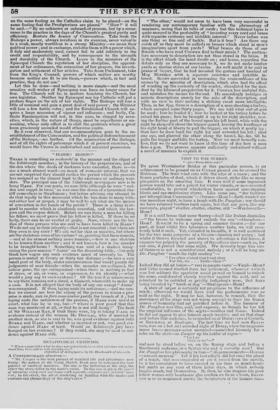METAPHYSICAL CRITICISM.
" When a man talks what he does not understand, to another who does not under- stand him, he is said to talk metaphysics."
Definitioa of Metaphysics, by the Blacksmith of GiammiS. A CONTEMPORARY observes- " Mr. Cooper is the best painter of nautical life and adventures now living: the author of the Naval Sketch Book may be esteemed the best painter of nautical manners. The one is the historian of the ship, the other the story-teller in the mate's cabin. To the one is given the power if investing every cord and brace with separate existence and imblible inte- rest; to the other, the art of rendering us familiar with the modes and
• customs and phraseology of the ship's crew." •
"The other," would not seem to have been very successful in rendering our contemporary familiar with the phraseology of mariners, seeing that he talks of cords; but this technical lapse is quite merged in the profundity of "investing every cord and brace with separate existence and indelible interest." Never before was any thing so fine said of tackle. But is it true ? Are there any cords (if so they must be called) or braces which stand in men's imaginations apart from yards ? What braces do those of our friends who have read COOPER find in their minds ? The particu- lars necessary to description are not thus stored in the brain. It is the effect which the mind dwells on ; and hence, regarding the details only as they are necessary to it, we do not make lumber yards of marine stores of our brains. As well might it be said in praise of SCOTT, that he had invested the garters and kerchief of Meg Merrilies with a separate existence and indelible in- terest. SCOTT succeeded in increasing the vraisemblance of his scenes by the minutise of description, which also had the effect of winding up :the curiosity of the reader, stimulated for the inci- dent by the laboured preparation for it. COOPER has imitated this, and mistakes the means for the end. He accordingly indulges in minute descriptions merely for the sake of the description, and with no view to their making a striking event more intelligible. Thus, in his Spy, there is a description of a man shooting a turkey, which occupies some thirty pages. We are told what sort of gun he used ; how he loaded it ; how he looked at the turkey before he raised his piece; how he brought it up to his right shoulder, rest- ing the further part of the barrel upon his left hand, while with the rig,ht he clasped it about the trigger-guard, leaving the forefinger of his right hand at liberty to pull the trigger, on which it gently lay ; then how he drew back his right leg and extended his left ; shut one eye, and glanced the other along the barrel, &c. &c. till he pulls the trigger and kills the turkey. Now we must honestly con- fess, that we do not want to know at this time of day how a man fires a gun. The process appears sufficiently understood without a novel of manners to explain it.


















 Previous page
Previous page